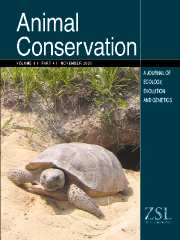Crossref Citations
This article has been cited by the following publications. This list is generated based on data provided by
Crossref.
Ortega, Jorge
Rosario Franco, María Del
Adams, Brice A.
Ralls, Katherine
and
Maldonado, Jesus E.
2004.
A reliable, non-invasive method for sex determination in the endangered San Joaquin kit fox (Vulpes macrotis mutica) and other canids.
Conservation Genetics,
Vol. 5,
Issue. 5,
p.
715.
Ortega, Jorge
Rosario Franco, Mar�a Del
Adams, Brice A.
Ralls, Katherine
and
Maldonado, Jesus E.
2004.
A reliable, non-invasive method for sex determination in the endangered San Joaquin kit fox (Vulpes macrotis mutica) and other canids.
Conservation Genetics,
Vol. 5,
Issue. 5,
p.
715.
Hepper, Peter G.
and
Wells, Deborah L.
2005.
How Many Footsteps Do Dogs Need to Determine the Direction of an Odour Trail?.
Chemical Senses,
Vol. 30,
Issue. 4,
p.
291.
Brown, Joshua
2005.
Sniffing with Precision. Detection dogs push the limits of field-monitoring techniques.
Conservation in Practice,
Vol. 6,
Issue. 2,
p.
94.
Prugh, Laura R.
and
Ritland, Carol E.
2005.
Molecular testing of observer identification of carnivore feces in the field.
Wildlife Society Bulletin,
Vol. 33,
Issue. 1,
p.
189.
Eggert, Lori S.
Maldonado, Jesús E.
and
Fleischer, Robert C.
2005.
Molecular Evolution: Producing the Biochemical Data.
Vol. 395,
Issue. ,
p.
73.
Smith, Deborah A.
Ralls, Katherine
Cypher, Brian L.
and
Maldonado, Jesús E.
2005.
Assessment of scat-detection dog surveys to determine kit fox distribution.
Wildlife Society Bulletin,
Vol. 33,
Issue. 3,
p.
897.
HARRISON, ROBERT L.
2006.
A Comparison of Survey Methods for Detecting Bobcats.
Wildlife Society Bulletin,
Vol. 34,
Issue. 2,
p.
548.
Noss, Reed F.
and
Daly, Kathleen M.
2006.
Connectivity Conservation.
p.
587.
BREMNER-HARRISON, SAMANTHA
HARRISON, STEPHEN W. R.
CYPHER, BRIAN L.
MURDOCH, JAMES D.
MALDONADO, JESUS
and
DARDEN, SAFI K.
2006.
Development of a Single-Sampling Noninvasive Hair Snare.
Wildlife Society Bulletin,
Vol. 34,
Issue. 2,
p.
456.
Cablk, Mary E.
and
Heaton, Jill S.
2006.
ACCURACY AND RELIABILITY OF DOGS IN SURVEYING FOR DESERT TORTOISE (GOPHERUS AGASSIZII).
Ecological Applications,
Vol. 16,
Issue. 5,
p.
1926.
Smith, Deborah A.
Ralls, Katherine
Cypher, Brian L.
Clark, Howard O.
Kelly, Patrick A.
Williams, Daniel F.
Maldonado, Jesús E.
and
Edwards, Cody W.
2006.
RELATIVE ABUNDANCE OF ENDANGERED SAN JOAQUIN KIT FOXES (VULPES MACROTIS MUTICA) BASED ON SCAT–DETECTION DOG SURVEYS.
The Southwestern Naturalist,
Vol. 51,
Issue. 2,
p.
210.
GOMPPER, MATTHEW E.
KAYS, ROLAND W.
RAY, JUSTINA C.
LAPOINT, SCOTT D.
BOGAN, DANIEL A.
and
CRYAN, JASON R.
2006.
A Comparison of Noninvasive Techniques to Survey Carnivore Communities in Northeastern North America.
Wildlife Society Bulletin,
Vol. 34,
Issue. 4,
p.
1142.
SMITH, D. A.
RALLS, K.
HURT, A.
ADAMS, B.
PARKER, M.
and
MALDONADO, J. E.
2006.
Assessing reliability of microsatellite genotypes from kit fox faecal samples using genetic and GIS analyses.
Molecular Ecology,
Vol. 15,
Issue. 2,
p.
387.
2007.
Predator-Prey Dynamics.
p.
205.
González, Susana
and
Duarte, José Mauricio Barbanti
2007.
Non invasive methods for genetic analysis applied to ecological and behavioral studies in Latino-America.
Revista Brasileira de Zootecnia,
Vol. 36,
Issue. suppl,
p.
89.
KERLEY, LINDA L.
and
SALKINA, GALINA P.
2007.
Using Scent‐Matching Dogs to Identify Individual Amur Tigers from Scats.
The Journal of Wildlife Management,
Vol. 71,
Issue. 4,
p.
1349.
LONG, ROBERT A.
DONOVAN, THERESE M.
MACKAY, PAULA
ZIELINSKI, WILLIAM J.
and
BUZAS, JEFFREY S.
2007.
Effectiveness of Scat Detection Dogs for Detecting Forest Carnivores.
The Journal of Wildlife Management,
Vol. 71,
Issue. 6,
p.
2007.
LONG, ROBERT A.
DONOVAN, THERESE M.
MACKAY, PAULA
ZIELINSKI, WILLIAM J.
and
BUZAS, JEFFREY S.
2007.
Comparing Scat Detection Dogs, Cameras, and Hair Snares for Surveying Carnivores.
The Journal of Wildlife Management,
Vol. 71,
Issue. 6,
p.
2018.
Reynolds, Scott D.
Christian, Daniel P.
and
Reynolds, Karen G.
2008.
Illicit Discharge Detection is Going to the Dogs.
p.
1.


